Blog •
Posted on Sep 13, 2022
Live Chat: How to Build Your Freelance Client Base
About the author
Reedsy's editorial team is a diverse group of industry experts devoted to helping authors write and publish beautiful books.
More about the Reedsy Editorial Team →Linnea Gradin
The editor-in-chief of the Reedsy Freelancer blog, Linnea is a writer and marketer with a degree from the University of Cambridge. Her focus is to provide aspiring editors and book designers with the resources to further their careers.
View profile →Below is the transcript of our webinar on How to Build Your Freelance Client Base, from September 6, 2022. It features advice on how to brand yourself and set up your professional profile to attract the right clients.
Guests:
Euan Monaghan is a book designer specializing in fiction and memoir, and who has worked directly with authors as well as for publishers like Melville House, World Editions and Zuleika. He designs covers driven by clear typography and strong imagery.
Rebecca Brewer is a freelance editor who specializes in science fiction, fantasy, horror and LGBTQ+ fiction. Previously, she was an acquiring editor at Ace, part of Penguin Random House.
This transcript has been edited for clarity and length.
Skip to 03:10 for the start of the discussion.
Origin stories
Rebecca Brewer: When I was about 16, I decided that editing science fiction and fantasy books was the best job in the world. So I got a degree in publishing and moved to New York City. There, I had an internship at ACE, worked at the Science Fiction Book Club, was an author, worked at Borders (R.I.P.) — and then when ACE had an opening, I immediately jumped on it.
About seven and a half years ago, when ACE were shifting their title count, I was no longer needed. I joined Reedsy thinking it would be a secondary thing to keep my toes in the water, but then it went much better than I ever expected, which was a very delightful surprise.
Euan Monaghan: My story is slightly less traditional. I started doing design while studying for an undergraduate degree in physics, actually. Around 2011, I started doing freelance work on the side and very slowly transitioned to full-time freelancing in 2017. I’ve been on Reedsy for almost 5 years.
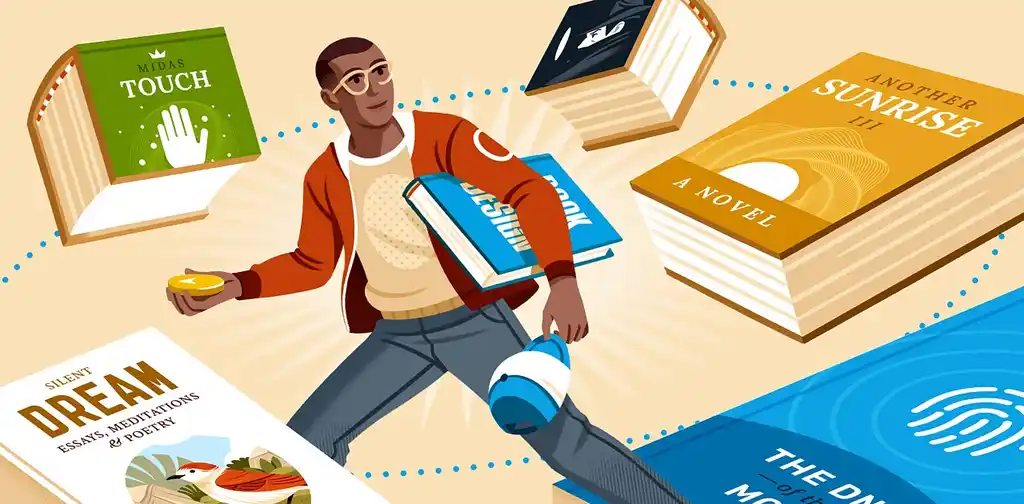
JOIN REEDSY
Find exciting new projects
We connect publishing professionals with our community of 1,500,000 authors.
Transitioning into freelance work
Euan Monaghan: Going freelance was a very gradual transition for me. Once I knew that I wanted to go full-time into design, it was a case of steadily building that up — Reedsy was a really helpful part of that, given the quality of the clients. There are many platforms, but many of them are bad. Like Rebecca touched on, it got bigger quicker than I expected.
Rebecca Brewer: I had gotten laid off from ACE and was looking for a complete career change. I thought I’d do freelance editing just to make a little bit of money while I figured things out. But then it only took me about a month and a half of being on Reedsy to realize that I was already making more money than I was at a publisher. My day also had a lot more variability, and I was doing less hours. I thought, ‘wow, I’m in charge and I make more money?’ Then I just ran with it.
I started doing developmental edits, copy edits, and editorial assessments. After a bit, I also started doing query letter critiques and sensitivity reads.
Euan Monaghan: 70% of my work is book interior design and typography, and 30% book covers. I enjoy working with covers when it’s something that really speaks to my kind of skill set, which is quite typography-led. That’s something that I always try to do [when building a client base]. I only take on stuff that I know that I can do — or if it pushes me, it pushes me just enough to be healthy. I’m not going to accept a job that I know I’m not going to be any good at because I know there are lots of other people who are going to be better at it than I am. And it would also be massively stressful.
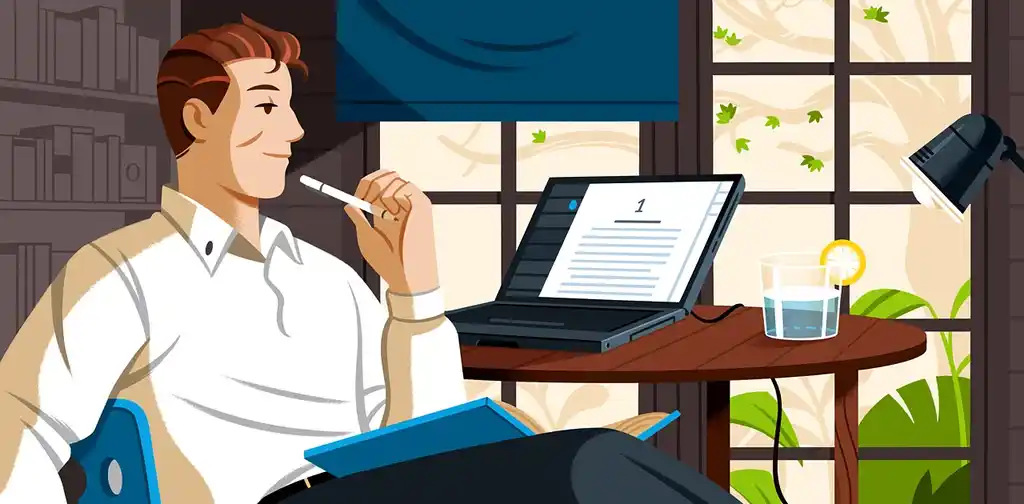
FREE RESOURCE
The Full-Time Freelancer's Checklist
Get our guide to financial and logistical planning. Then, claim your independence.
Q: What have you found most helpful in building your client base as a freelancer?
Suggested answer
Being as courteous, helpful and listening to their ideas. Since most my clients are self-publishing writers, I find that many are first time publishers and when I use my expertise to help them through the process, they are very appreciative. This means a portion of them come back for their next project.
Kelly is available to hire on Reedsy ⏺
If you have connections in the areas you want to work then you need to use these contacts well. Tell people when you are starting out, tell them when you are looking for new work, and ask for referrals. Word of mouth, for me, is absolutely the best way to get work and grow my client list.
However! Even if you do have these contacts when you start out, but ESPECIALLY if you don't... You have to market yourself for potential clients - and the clients you want - to find you. There are lots of ways to do this, but at the most basic level add yourself to some freelance databases (specifically editing-, book-, publishing-related ones) and a site like Reedsy.com! I would also highly recommend a website - even a very simple one-pager - so potential clients can find you and what you are about. You need to be google-able!
A presence on social media and networks or via a newsletter can all be very helpful too, depending on your desire to do these things. Clients need to be able to find you and work out that you offer them what they are looking for.
Even when I am busy and booked ahead for some time, I still post on my social media accounts, send out my newsletter and update spaces like Reedsy and my website - it helps ensure that when someone might need my services in the future that I come to mind.
Lauren is available to hire on Reedsy ⏺
The straightforward answer is Reedsy.
I have been a freelance illustrator for over 30 years, and the industry has undergone incredible changes. When I started, computers were mainly used for typesetting text, which was printed on photographic paper, cut out, and then stuck onto a board with wax. Getting work as a freelancer back then was all about wearing out shoe leather; you had to drag your portfolio around to publishers and advertising companies.
Fast forward 30 years, and while you still need to do the legwork and get your portfolio in front of the right people, the process has moved online.
The key is still the same: get your portfolio seen by the right people. I specialize in children's books, and my online presence is consistent across all platforms. My website and social media accounts clearly convey that I focus on children's books. I also maintain an online portfolio with SCBWI (The Society of Children's Book Writers and Illustrators). Additionally, I attend kidlit conferences that offer opportunities to meet publishers. The more often your name crosses an editor's desk, the better.
However, when it came to showcasing my portfolio to the right audience, joining Reedsy as a professional was the best decision I ever made—better even than finding an agent. By listing on Reedsy, my portfolio is now in front of authors looking to hire an illustrator.
I'm sorry if this sounds like an advertisement, I don't mean it to be. For me, Reedsy is the right marketplace for my work to be seen by the people most likely to hire a freelancer.
Vaughan is available to hire on Reedsy ⏺
Relationships! Whether it's an editor giving me an assignment or a client hiring me to ghostwrite a book with them, I want to deliver a great experience. Of course the work has to be good - that's a given. What people will remember, however, is how you made them feel. I want my clients to know I'll always be on time, thorough, open to feedback, and, most importantly, warm and friendly. Hiring a ghostwriter is a leap of faith and I always want my clients to feel supported and safe.
Ceri is available to hire on Reedsy ⏺
Treat them well and keep them happy so they want to work with you again. I am always, always friendly and professional (which can be a challenge every so often!) because I want the customer to be happy, and I want them to enjoy working with me again.
At my other freelancing site, what also helps is that the freelance writers recommend me to customers, so, again, I catch more fabulous flies with honey than with vinegar.
Jenny is available to hire on Reedsy ⏺
Setting up your Reedsy profile
When you sign up to Reedsy, we ask you to complete a profile. This is the page that will introduce you to potential clients. Your profile will ideally compel authors to request a quote for your services and begin a collaboration.
Euan’s profile
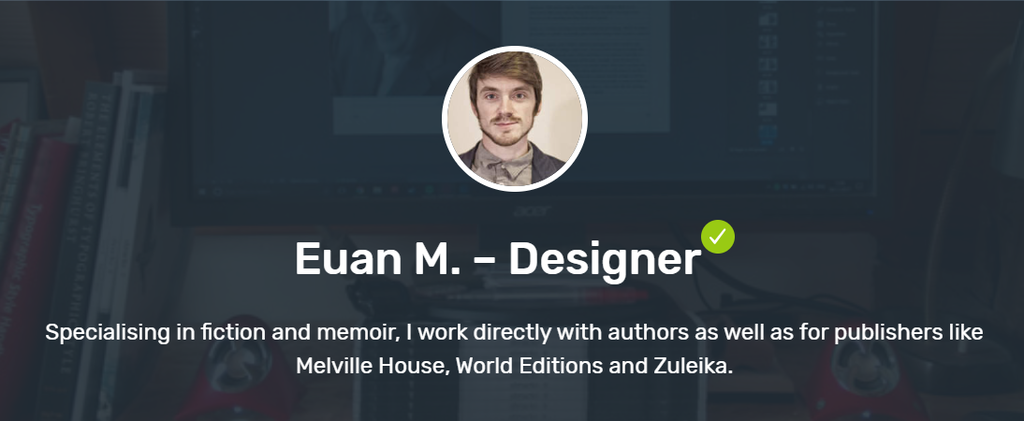
Martin: One of the primary purposes of your profile is to convince clients who have never really worked with editors or designers before that there’s an actual person behind the screen. Little details like “I’m British but I live in the Hague now,” a good photo, and stuff that shows a bit of personality are super helpful.
Euan, in your overview, you also have a single line that stands out: “I design both covers and the internals of books.” Is that something you’ve had on your profile from the beginning?
Euan Monaghan: I didn’t have it on its own originally, but I found that when people think about book design, they usually think of covers. Reedsy has a really good tool for doing the internals for books, but I think it helps to remind people that if they want something a bit more complex or push it to the next level, [there are people out there who design the inside too].
After that, I wanted to show what I do and what my process looks like — that my designs go from print books to ebooks very easily — and what my strengths are. If I haven’t mentioned something that a client is looking for, that’s a sign that maybe I’m not the right person for them. On the other hand, if strong typography sounds like something they want to do, [I might be who they’re looking for]. Really, I want to attract requests from people who like my stuff and the way I work. I take them through the process because that’s how I would have wanted it to be.
Martin: And then at the bottom, you have your bona fides, stating which guilds you’re a member of, acting as a qualifier.
Euan Monaghan: Yeah, it helps to have some badges, doesn't it?
Martin: I don’t think it’s something people actively search for, but it can help close the deal. After that, you list what services you offer. Has anyone ever requested just typography?

Euan Monaghan: Yes, it was a custom lettering type design for a book which already had the artwork and back cover complete, and they wanted something a little different for the lettering. The artwork was supplied and I added a mix of hand lettering and type design to fit in around the imagery.
I usually don’t illustrate from scratch. My usual remit is working with illustrations or photography or type itself. For El Llano in Flames, for instance, I used satellite imagery from NASA, which I built into a topographic map of the area where the book is set. It also had foiling. It was a proper work of passion for me. Doing covers with typography over photographs can take as much work as something which is heavily illustrative.
Choosing your portfolio
Martin: Since design is such a visual medium, can you talk us through how you chose your portfolio?
Euan Monaghan: It was tricky. The portfolio only shows covers and because I also do internals, I didn’t want the portfolio to be too long. I wanted potential clients to get to the point sooner. I also wanted to show a variety; there are a couple of languages there to remind people that if they’re writing something in German, that’s fine. Then there’s some photography, some illustration, and some designs which are more customized — and others that are slightly less customized.
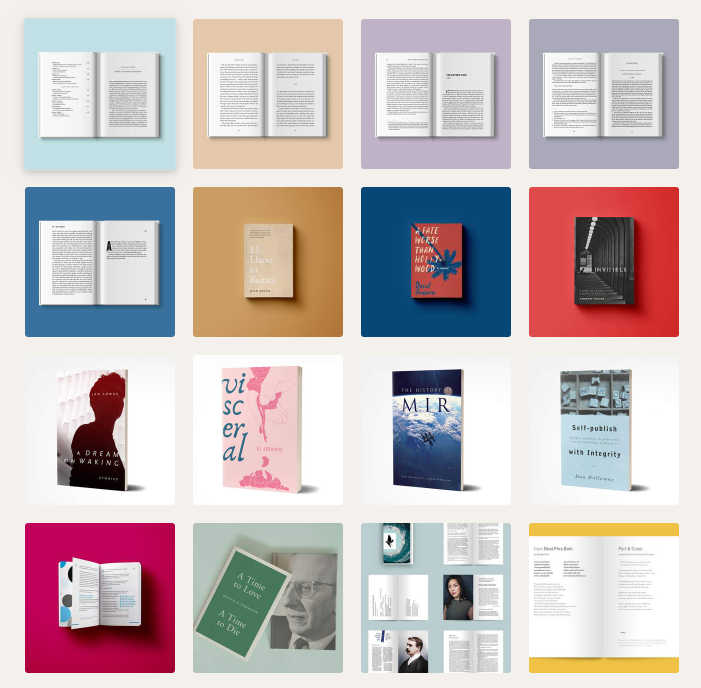
Rebecca’s profile
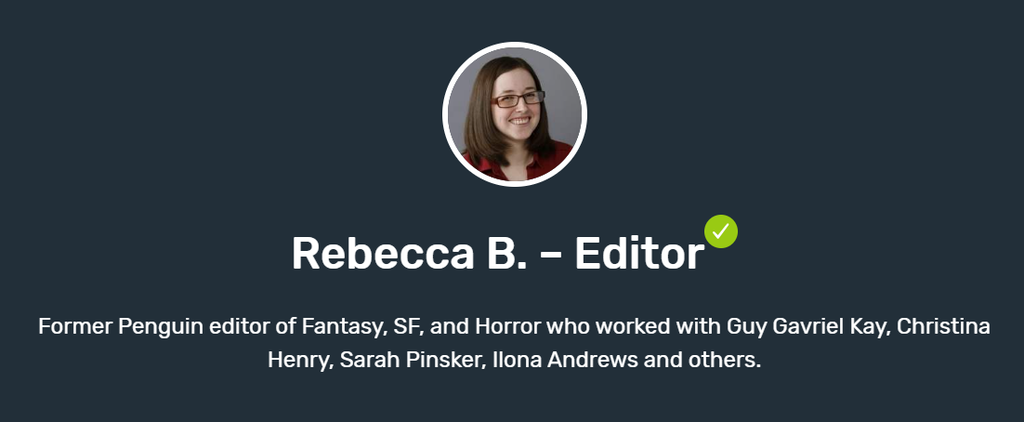
Rebecca Brewer: When I first set up my Reedsy profile, I included information about where I had worked previously and what I specialize in, but later on, when I was looking at other freelancers providing the services that I do on the marketplace, I noticed that some of the people who had a lot of reviews — which I assumed meant they had a lot of business — were using author names on their profiles. I thought that was a good idea because it brands you while also giving you bona fides at the same time. And I really love when an author mentions that they love another author’s work because then we can geek out about it together.
Martin: You also start naming some of the subgenres you work with in your overview. This is great because the Reedsy search engine will pick up on that if it’s in the body of your text, which helps you put yourself out there.
Q: How do you tailor your profile on Reedsy to attract your ideal clients?
Suggested answer
My profile is designed to be clear and transparent, offering as much information upfront as possible. To achieve this, I've organised it into the following sections:
Introduction
Here, I share my background and expertise as a designer, highlighting my ability to meet diverse client needs while consistently delivering exceptional creativity and professionalism.
Services
In this section, I detail the services I provide, emphasising my expertise in delivering high-quality design solutions across various mediums. I also highlight my technical support for authors at any stage of their publishing journey, along with my dedication to minimalistic design and meticulous attention to detail.
How I work
In this section, I describe my design approach, which consists of three phases: Analysis, Ideation & Creation, and Delivery.
Frequently asked Questions
Lastly, I address some common questions about my design process, providing clarity and setting expectations for clients. These include project turnaround time, questions about rights ownership and the use of generative AI.
Jonathan is available to hire on Reedsy ⏺
When I first joined Reedsy, I was already working freelance, having recently left a brief but formative role at a London literary agency where I quickly learnt the foundations of my craft. I was also a single parent raising two teenagers, balancing manuscript deadlines with school runs and meal prep. Life was busy, but I was determined to make it work.
At first, my profile was simple. I wasn’t trying to compete with anyone; I just wanted to speak honestly about what I could offer. But over time, I learnt that on Reedsy, your profile is more than a CV. It’s your calling card. A shop window. And to attract the right clients, you need to be clear, warm, and specific.
Start With a Promise
Your headline should reflect not just what you do, but why it matters. Mine reads:
Bring Your Story to Life With Expert Editorial Insight That Delivers Results
This line sets the tone for the entire profile. It’s confident, helpful and outcome-focused.
Make It Personal
In the opening paragraph, I introduce myself simply and warmly. Writers aren’t just hiring an editor; they’re choosing a partner. So it helps to sound like a real person, not a list of qualifications.
Be Clear About What You Offer
Rather than use vague phrases like “manuscript help”, I list exactly what my developmental editing covers: plot, pacing, character depth, narrative voice and more. I also include extras such as an editorial report and post-edit support, so writers know what to expect.
Show Results
One of the most effective parts of my profile is a success story. I include a client quote and mention that, after working with me, he signed with Trident Media Group in New York. Testimonials build trust, but they’re even more powerful when linked to real outcomes.
Tailor Services to the Writer’s Journey
Because many of my clients are preparing to submit, I also offer an agent submission package. This includes a query letter, synopsis, pitch, press release and targeting tips. It’s clear, actionable, and helps authors move forward with confidence.
Keep Qualifications Simple
Rather than list every course I’ve taken, I include only those that are relevant and meaningful. I mention that I’m a qualified copywriter and an active member of editorial bodies such as the CIEP and EFA.
Final Thought
Your profile should reflect who you are and how you work. Be yourself, be clear, and speak to the kind of writers you truly want to support. The right clients will recognise themselves in your words — and they’ll reach out.
Shelley is available to hire on Reedsy ⏺
In my Reedsy profile, I emphasize that I work with an author's vision, rather than opposing or debunking it. There are two reasons for this. First, I know many authors worry about hiring a professional who will encourage them to head off in a direction they have no desire to go. I want authors to know from the outset that I'll work alongside them, never cutting against the grain or recommending a revision tack they've already ruled out. Second, I hope to attract authors to me who already have a specific plans, tastes, aesthetics for their manuscripts. By advertising that I'll work with them, I hope prospective clients feel affirmed; I know how much thought, intention, and care they've already invested into their projects so far.
Kevin is available to hire on Reedsy ⏺
Tip: Setting up your genres
Martin: When setting up your Reedsy profile, you can select up to eight genre tags to indicate the types of books you specialize in. When you select a subgenre, for example, "Urban Fantasy," you will also turn up in searches for the parent category, "Fantasy." With this in mind, you should aim to be as specific as possible in selecting your categories and focus on subgenres.
In addition, you can 'star' two genres that are your specific areas of expertise. You will appear higher in searches for these terms by starring a genre.
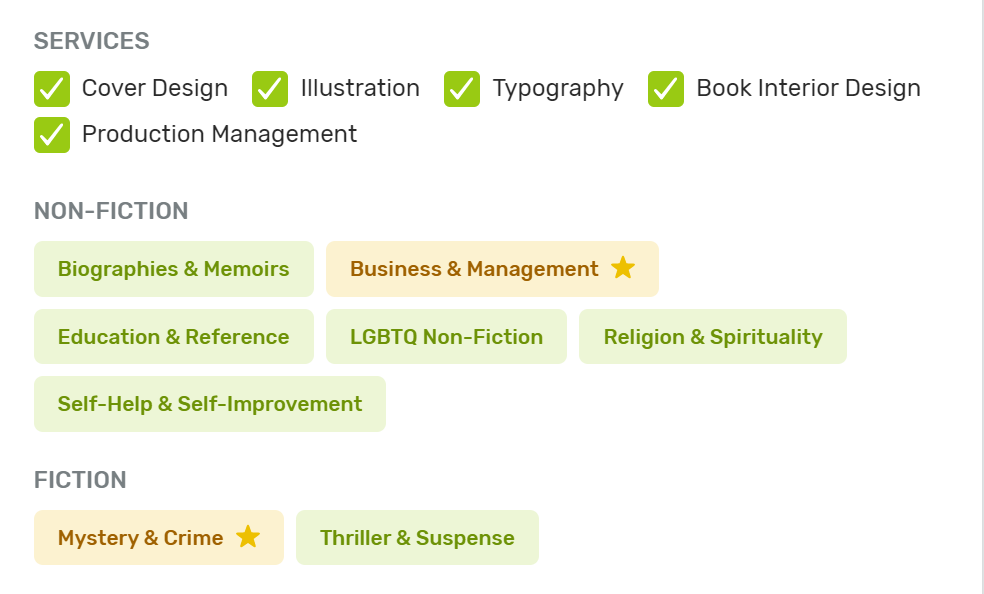
Euan Monaghan: I’ve added categories like ‘literary fiction’ and ‘science fiction’ since I find a lot of visual interest in those genres. Designing for LGBTQ fiction is often really interesting too, and adding that to my profile has had the lovely side effect of stopping a certain type of person from messaging me or asking for a quote — which in all seriousness, has been really helpful.
The profile is a case of saying, “hey, here’s a bunch of stuff I have a lot of experience in; here’s a publisher I work with; this is something I’m pretty good at.” It’s about showing the things you’re interested in and have a wider knowledge of.
Asking questions to curate your client list
Rebecca Brewer: I think my ability to pick the clients I enjoy working with has improved over the years. The first thing I ask clients, which can be a stumbling block to a lot of people, is for more information about their project. A fairly large amount of people never respond to the questions that I have, which tells me they aren't as savvy as I want them to be.
It’s helpful when authors explain what they're hoping to achieve. Combined with the sample pages they give me, I can get a good sense of them and the project, because I don’t want to work with somebody who’s [not ready yet and is] going to need a tremendous amount of work.
Euan Monaghan: If they haven't given a very detailed brief, I ask questions about simple things like deadlines and about the project to find out if I'm available at that time and the right person for the job. I’d perhaps ask them to add a couple of images that have inspired them or that they may be aiming for.
If they’re aiming for illustration, I might ask if they’ve thought to hire an illustrator from the marketplace, since I’m not an illustrator. I think that gives them the confidence as well — that you’re not just taking on everything and trying to get work no matter what. So it’s a win-win because I get to work with people who know what they’re getting into and that they want to work with me.
Developing strong editor-client relationships
Rebecca Brewer: As an editor, I get to sort of see how my client’s mind works. Once I send off my edits, we do a zoom call, and it’s almost like I finally get to meet the person I already know. Sometimes my questions about the book (e.g. what does this event mean to the main character?) end up bringing up some of their own personal feelings. One person told me I was the best therapist they’d ever had, which was really rewarding — to know that I had helped with the book but also with their life.
I think for a lot of [indie] authors, I'm the first person that ever reads their book. And a lot of them are terrified that I'm going to tell them that they should give up and that their book is absolutely awful. So it’s part of my job to help them learn and to reassure them that there is value in what they’re doing. I try to have a soft touch when it comes to my authors. I want to help them. I don't want to scare them away. So I usually ask a lot of questions, make some suggestions so that they can feel their own way and internalize how to structure a book.
Getting customer testimonials
Positive customer testimonials on your profile can set you apart from the competition and convince a client to hire you instead of another freelancer. If you’re new on the platform and haven’t had any collaborations yet, you can add testimonials from authors you’ve worked with off the platform in your overview section until you’ve drummed up some reviews from Reedsy clients.
Euan Monaghan: Reedsy is pretty good at helping you get testimonials. I think it gives people a prompt once a collaboration is done. I have a few messages saved in a text document that I use to let clients know that we’ve finished the project and to ask if they’ve had any issues uploading any of the files, so it’s a very clear end to the collaboration in that sense.
Martin: We find that getting reviews is quite important. I guess the good thing about working with authors is that they’re usually a bit more detailed with their write-ups! Have you ever found an author to refer back to feedback in your testimonials?
Rebecca Brewer: Yes, I have. And I’ve had a couple of repeat clients, which is always nice. I don’t actually prod them to review, which I’m now thinking is something I should consider doing. Especially when I’ve had a really great conversation with an author and they feel really excited to get back into their book and start working.
Martin: The good thing about testimonials is that authors want to know what the experience of working with a freelancer is going to be like. I’ve seen a lot of freelancers adding testimonials to their overview section because, in a way, you’re selling the experience of working with you.
Getting repeat clients
Euna Monaghan: I’ve had a few repeat clients and I think, to foster that, I aim to communicate really clearly and to produce a good thing. It sounds like I’m trivializing the question, but if the client has a positive experience working with you, they might come back to you and ask for more work.
Rebecca Brewer: My clients often come back to me for their shorter work, especially if I worked on their novel and they then wrote a short story. It’s nice to check in with them again.
One thing that is really helpful [for getting repeat clients] is to be very specific with the services that you’re going to include, because a lot of authors aren’t really sure what they’re going to get. Trying to be very clear about what they’re going to get and at what date [contributes to clear communication and a positive experience overall]. And for me, I always tell my clients that I'm an ongoing resource. If they have questions 6 months from now, I'm still here.
Q: How do you build long-term relationships with authors to encourage repeat business?
Suggested answer
Before I was a freelance editor, I was a teacher. I taught writers preparing for college, in college, and in continuing education program. One of my favorite parts of teaching was talking with my students about their goals outside my class and working on how my class could help them reach those goals. I take the same approach as an editor. At the start of a project, I ask questions that get into the root of what my clients are hoping to gain from their writing as a whole, not just for one piece. My main focus is on the piece I am editing, yes, but it is very valuable to find out where this one piece fits in my client's journey as a writer. On a practical note, at the end of a project, I always ask my clients to keep me posted. Then, a couple times a year, I go through my closed projects and check in with any clients I haven't heard from recently.
Tracy is available to hire on Reedsy ⏺
I am interested in making a manuscript as good as it can be, but I see that as only part of my job. I am also interested in building the careers of writers. I consider myself an editor, yes, but also a saleswoman of the people I believe in, attempting to connect writers to opportunities (publishers, agents, speaking engagements, etc.), develop their skills, and, perhaps most importantly, their confidence in themselves. I believe it's for this reason that my business is primarily made up of repeat writers and long-standing professional relationships.
Holly is available to hire on Reedsy ⏺
If there’s one thing you could tell yourself before you became a freelancer, what would it be?
Euan Monaghan: I think that what I'm doing now, compared to what I was doing in the beginning, is that I'm working significantly less hours and doing much better work. In the beginning, I thought freelance work meant that I had to be at my desk or in the studio all the time. But that actually isn’t quality hours. I would have saved myself a lot of heartache if I had realized that a lot earlier and given myself permission to know when to be productive and when to take a break. It actually requires quite a lot of discipline to work less, as silly as that sounds.
I also want to mention one more thing about testimonials. I find that, as someone who occasionally suffers from imposter syndrome, having consistent objective feedback from people who have no ulterior motive, has been fantastically helpful for someone who is self-taught. It keeps the inner critic at bay. It can give a boost at the start of a day, especially when you work on your own.
Rebecca Brewer: I would have told myself two things. The first one is that you don’t need to undervalue your skills. When I first started, I didn’t really have a good sense of how much to charge. Reedsy has these average prices, which was very helpful, but since I didn’t have any reviews yet, I thought I needed to go lower to get clients. That was not the case — perhaps because I have the bona fides. It’s a balance of ‘my prices’ versus ‘my hours’, so I change my pricing depending on my schedule and my needs. And secondly, like Euan said, you have to schedule time off, which took me a while too. Making sure to not go overboard with work and to give yourself breaks is really important.
Tips from Reedsy
Martin: Continuing from what Rebecca said in terms of pricing yourself, you ideally should be increasing your rates as you progress in your career. Having seen a lot of requests and quotes betweens clients and freelancers on Reedsy, fewer authors than you’d imagine go for the lowest price on offer. You don't want to chase yourself to the bottom; you want to be the one where they feel that they're getting good value. A lot of that also stems from the communication in that first email — letting them know what they can expect to get.
The other part is to let people know who you are when you’re setting up a profile. That tends to mean having a picture of yourself, ideally smiling. We actually ran some data and found that freelancers who had a moody, back-lit profile photo with a filter on got very few requests. Sometimes, all you need is something that says “Hi, I’m a friendly person who will be nice to work with.” Sometimes that’s enough.
Q&A session
Question: Euan, where did you find the background with books on them to place your designs on? Are they templates?
Euan Monaghan: Yes, some of them are paid for [templates], but there are a few on there which I found on covervault.com as a free resource. The designer who makes these has a massive zip file you can buy, but he also gives away some very high quality book mockups for free. I usually strip them back because they have backgrounds and things that I don't care about and they’re just layered photoshop files. If you search for book mockups, you can find some really good quality stuff. Often it’s paid for, but it’s worth it.
Question: One of my authors is suddenly ghosting me. Is there a procedure for dealing with that situation?
Rebecca Brewer: I’ve been very lucky, but there have been a couple of instances where I’ve sent my edits and didn’t hear from the author. Usually, there were other circumstances involved though.
I did have one potential client who was very combative and aggressive and was giving signs that he didn’t really want to work with me. So I gave him an out since we hadn’t officially started the collaboration yet. Sometimes they might not be checking their Reedsy messages. It might be going into spam. It really depends.
Euan Monaghan: Similarly, I’ve only very occasionally run into a situation like that. But Reedsy support is super responsive so if you need them, just click the “help!” button at the top.
Martin: Billing and chasing people up is perhaps the least favorite part of being a freelancer so that’s one of the benefits we try to offer our freelancers. If a conflict arises, someone from our team will mediate and try to come to a resolution that works for everyone. Our aim is to both make sure that the freelancers are protected and that authors can feel some assurance as well.
Question: How much do you actually contact clients?
Rebecca Brewer: I send my edits to a client as a full package, all at once but sometimes I tell clients that they can let me know if they have questions in the meanwhile. I’ll also let them know if I’m on time for the deadline or running a bit behind. After the edit, I’m open for questions for any period of time.
Question: How do you handle clients who have unrealistic expectations of how much an edit or design costs?
Euan Monaghan: I generally point people towards some of the articles that Reedsy has about how much things cost. That also means that I don’t have to be the one to break it to them.
Reedsy has articles to help freelancers set their base rates — editing rates, proofreading rates, designer rates, and ghostwriting rates — that can also be a helpful resource to send to authors.
Rebecca Brewer: It happens very often that people have unrealistic expectations, but I think once they see that four or five quotes are almost three times as high as what they thought — when they ask a qualified person — they understand. And I’ve actually received a lot of apologies for that.
One thing I occasionally do if somebody asks for a developmental edit but they have a smaller budget, I’ll ask if they’ve considered an editorial assessment instead. Then I’ll give a quote for that as well so they can get a sense [of the price point].
Euan Monaghan: Cover designs can be anything from €300 to €1000, depending on how much is involved — what kind of cover it is, whether it’s a full dust jacket, or whether it’s part of a series with preexisting design, and so on.
Question: Do you give your quote to clients right away or do you chat with them first?
Euan Monaghan: It’s very rare that I get a brief that’s complete enough to give a quote immediately so I often get back to them and ask a few more questions. That also gives me a chance to check whether I’m the best designer for the job.
Rebecca Brewer: For me, I always ask for more information, and that includes a synopsis. That immediately tells me if I’d enjoy the book regardless of how well-executed it is. Between the synopsis, their answers [to my questions], and their sample pages, I can give a quote.
Question: Do you require a signed contract before you begin a collaboration? What do Reedsy contracts look like?
Rebecca Brewer: There is a basic contract that Reedsy already has, but they do have the option to upload your own as well. I’ve never used that. Reedsy’s contract is very handy because they chase the money for me if somebody isn’t paying. Everything is laid out; I’m very clear about what they'll receive, the timeline and the cost. So that’s never really been an issue.
If it’s someone else, like a publishing house for instance, I do require a signed contract, but with Reedsy it’s kind of baked into the system.
Martin: I believe you have options to set a schedule and change the delivery times if you need to, or if they’re struggling to make the payment schedule. We usually don’t suggest delivering the project until the payment has been made.
That’s it for today folks. Thanks so much for joining us!
For updates on upcoming webinars with top publishing professionals, subscribe to our Freelancer newsletter or follow us on LinkedIn.


